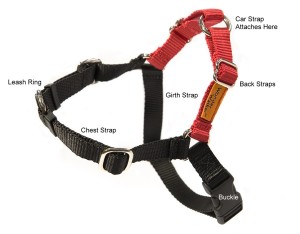We find that these harnesses are minimally aversive (i.e. unpleasant) for most dogs. While they don’t provide as much control (turning power) as a head halter, most dogs are able to get used to them much faster than head halters, which makes them a great training tool.
How do Front-Clip Dog Harnesses Work?
The purpose of a front clip harness is to provide you with extra control over your dog by making turning their body away from something easier to do. When your dog pulls towards something, the front leash attachment point causes them to pivot around their chest toward you.
Different Styles
There are a number of different styles of front-clip dog harnesses available now. We prefer to purchase these from our local pet stores, but many of the “Big Chain” stores carry them as well. Here are a few of the available styles and some of their characteristics:
Freedom Harness
-
The Freedom Harness features a back and front attachment point (some believe that this helps to better control the dog)
- One of our favorite features is the felt-covered strap material around the armpits that protects your dog’s skin
- Back attachment is a “martingale” style (limited-slip) point
- Some models include a double-ended leash to attach to the top and front, though these may need to be purchased separately
- Fit on these may be a little looser during non-pulling times, increasing comfort, and snugger during pulling to help turning
- Comes in a HUGE variety of colors
- Includes a special “chewing warranty” against damage (you pay only shipping)
Sensible Harness
- The original front-clip style harness by Soft Touch Concepts
- Features a single attachment point in the front with a vertical (flat to the chest) O-ring style attachment point
- Colors are limited (black, blue, red)
Wonder Walker
- The Wonder Walker dog harness is produced in Seattle, Washington (we like local-ish products) and are available at a number of smaller pet boutiques here in Portland, Oregon
- These harnesses come in a wide variety of colors
- While these are similar in most respects to the Sensible harness, the side attachments for the straps are shaped as a triangle. This may have been done to help minimize the chest strap downward slipping that sometimes takes place.
Expensive Chew Toy
Don’t leave your dog alone an unsupervised with the harness on! We have gotten reports from a number of our clients (and have witnessed a few incidents) where a dog will work their mouth into a position where they can chew at the chest strap. This can destroy the harness and make for an expensive chew toy. If you think this might be likely, consider purchasing the Freedom harness which features the “chewing warranty” for a small replacement cost.
If you are experiencing dog behavior problems we can help! We offer online classes & webinars!
Also see our popular post all about dog muzzles.
Fitting Tips and Helpful Alterations
For some dogs, particularly the short-armpit-to-elbow-length dogs, fitting to prevent slipping out of the harness can sometimes be challenging. Fitting the harness so that the chest strap sits higher on the chest usually makes the fit better. It may also reduce the likelihood of slipping out of the harness for these types of dogs.
In some cases finding this better fit can be achieved (due to differences in the length of the top and bottom straps in some models) by flipping the harness upside down, and placing the belly strap on the top instead of the bottom, contrary to the harness instructions.
Some thin-skinned, short-furred, or sensitive dogs can benefit by retrofitting polar-fleece coverings on the straps to prevent chafing from taking place. This irritation can occur particularly in the armpit areas. You can alternately use the Freedom Harness with its built-in felt coverings on the straps.
If you are afraid that your dog might back out of the harness and escape, attach the leash clip to both the chest loop and your dog’s regular collar. This makes it harder for your dog to pull a Houdini but may decrease the amount of control that the harness gives you.
Tips to Introduce the Front-Clip Harness
When you start using the harness to walk your dog, they may need a little time to adjust to the new leash attachment point and to how it re-directs their motion. Take your time in guiding your dog to gently turn towards you and get rewarded for doing so.
Try to not rely on the harness to turn your dog, instead see if you can use your voice (and treats if necessary) to guide their motion. Take a class to learn how to teach your dog leash-walking skills so that the harness is only there as an “emergency back-up plan” rather than the primary means of stopping pulling.
Get out there and enjoy your dog! 🙂



